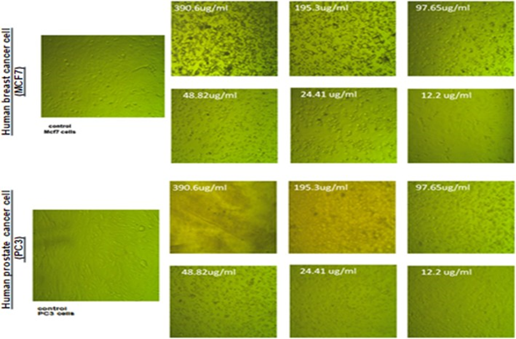Abstract
ZnO-NPs have displayed anticancer activity against a broad range of tumor cells. The present research work was planned to formulate highly pure and well-characterized ZnO-NPs, in addition, to investigate their cytotoxicity against two types of cancer cells. The cancer cells that had been investigated in the present study were breast (MCF7) and prostate (PC3) cancer cells. The aqueous sol-gel method is a powerful and cost-effective technique for the synthesis of high pure ZnO-NPs. While the anticancer activities of ZnO- NPs on both MCF7 and PC3 were determined by MTT assay. Characterizations of ZnO-NPs were fundamentally evaluated by their morphological and structural properties, in addition to their particle size distribution with the aid of SEM and EDX, respectively. ZnO NPs were successfully prepared using sol-gel method in a range of nano-scale. Scanning electron microscopy (SEM) has shown flower-like nanoparticles of zinc oxide, their nano-size has ranged from 4.497 nm. to 143.7 nm. Results of EDX characterization has exhibited a good purity of ZnO-NPs (zinc content of 50% and Oxygen content of 50 %). There was size-dependent effectiveness of ZnO-NPs as an anticancer agent on both MCF7 and PC3. In addition, there were positive correlation between anti-cancer activities and low toxicity with the size of ZnO-NPs. At 12.2 µg/ml, ZnO- NPs has exhibited around 51% reduction in the viability of cancerous cells. In conclusion, the results of this study have shown that there was an effective and notable dose-dependent manner in the treatment of MCF7 and PC3 with ZnO-NPs, in the cell line approaches.
Full text article
References
Bray, F., Ferlay, J., et al. 2020. Ahmedin Jemal, Global cancer statistics 2018: GLOBOCAN estimates of incidence and mortality worldwide for 36 cancers in 185 countries. A Cancer Journal for Clinicians, 70:313–313.
Chao, C. H., Wei, D. H. 2015. Synthesis and Characterization of High c-axis ZnO Thin Film by Plasma Enhanced Chemical Vapor Deposition System and its UV Photodetector Application. Journal of visualized experiments: JoVE, (104).
Haarindraprasad, R., Hashim, U., et al. 2015. Low Temperature Annealed Zinc Oxide Nanostructured Thin Film-Based Transducers: Characterization for Sensing Applications. PLOS ONE, 10(7):e0132755–e0132755.
Hasnidawani, J. N., Azlina, H. N., et al. 2016. Synthesis of ZnO Nanostructures Using Sol-Gel Method. Procedia Chemistry, 19:211–216.
Król, A., Pomastowski, P., et al. 2017. Zinc oxide nanoparticles: Synthesis, antiseptic activity and toxicity mechanism. Advances in Colloid and Interface Science, 249:37–52.
Perumal, V., Hashim, U., et al. 2015. Thickness Dependent Nanostructural, Morphological, Optical and Impedometric Analyses of Zinc Oxide-Gold Hybrids: Nanoparticle to Thin Film. PLOS ONE, 10(12):e0144964–e0144964.
Tanino, R., Amano, Y., et al. 2020. Anticancer Activity of ZnO Nanoparticles against Human Small-Cell Lung Cancer in an Orthotopic Mouse Model. Molecular Cancer Therapeutics, 19(2):502–512.
Van Meerloo, J., Kaspers, G. J., et al. 2011. Cell sensitivity assays: the MTT assay. Methods in molecular biology, 731:237–245.
Wang, J., Gao, S., et al. 2018. Zinc oxide nanoparticles induce toxicity in CAL 27 oral cancer cell lines by activating PINK1/Parkin-mediated mitophagy. International journal of nanomedicine, 13:3441– 3450.
Xu, L., Li, X., Chen, Y., Xu, F. 2011. Structural and optical properties of ZnO thin films prepared by solgel method with different thickness. Appl Surf Sci, 257(9):4031–4037.
Authors

This work is licensed under a Creative Commons Attribution-NonCommercial-NoDerivatives 4.0 International License.

